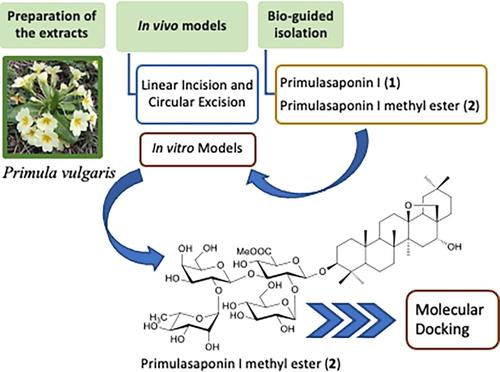当前位置:
X-MOL 学术
›
Chem. Biodivers.
›
论文详情
Our official English website, www.x-mol.net, welcomes your feedback! (Note: you will need to create a separate account there.)
Bioactive Saponins of Primula vulgaris Huds. Promote Wound Healing through Inhibition of Collagenase and Elastase Enzymes: in Vivo, in Vitro and in Silico Evaluations
Chemistry & Biodiversity ( IF 2.9 ) Pub Date : 2022-10-30 , DOI: 10.1002/cbdv.202200582 Cigdem Kahraman 1 , Suat Sari 2 , Esra Küpeli Akkol 3 , Irem Tatli Cankaya 4
Chemistry & Biodiversity ( IF 2.9 ) Pub Date : 2022-10-30 , DOI: 10.1002/cbdv.202200582 Cigdem Kahraman 1 , Suat Sari 2 , Esra Küpeli Akkol 3 , Irem Tatli Cankaya 4
Affiliation

|
Primula vulgaris Huds. leaves and roots were used to treat skin damage and inflammation in Anatolian Folk Medicine. This study aimed to assess the ethnopharmacological use of the plant using in vivo, in vitro, and in silico test models. Linear incision and circular excision wound models were used to determine the in vivo wound-healing potential of the plant extracts and fractions. In vitro assays including hyaluronidase, collagenase, and elastase inhibitory activities were carried out for the active compounds to discover their activity pathways. Structure-based molecular modeling was performed to understand inhibitory mechanisms regarding collagenase and elastase at the molecular level. The butanol fraction of the roots of P. vulgaris showed the highest wound-healing activity. Through activity-guided fractionation and isolation techniques, primulasaponin I (1) and primulasaponin I methyl ester (2) were stated as the major active compounds. These compounds exerted their activities through the inhibition of collagenase and elastase enzymes. Primulasaponin I methyl ester isolated from butanol fraction was found to be the strongest agent, especially with the values of 29.65 % on collagenase and 38.92 % on elastase inhibitory activity assays, as well as molecular docking studies. The present study supports scientific data for the traditional use of P. vulgaris and the wound healing properties of the plant can be referred to secondary metabolites as especially saponins found in the roots.
中文翻译:

报春花 Huds 的生物活性皂苷。通过抑制胶原酶和弹性蛋白酶促进伤口愈合:体内、体外和计算机评估
报春花寻常Huds。在安纳托利亚民间医学中,叶子和根被用来治疗皮肤损伤和炎症。本研究旨在使用体内、体外和计算机测试模型评估植物的民族药理学用途。使用线性切口和圆形切除伤口模型来确定植物提取物和组分的体内伤口愈合潜力。体外对活性化合物进行了包括透明质酸酶、胶原酶和弹性蛋白酶抑制活性在内的测定,以发现它们的活性途径。进行了基于结构的分子建模,以了解分子水平上胶原酶和弹性蛋白酶的抑制机制。P. vulgaris根的丁醇部分显示出最高的伤口愈合活性。通过活性引导的分馏和分离技术,报春花皂苷 I ( 1 ) 和报春花皂苷 I 甲酯 ( 2) 被列为主要的活性化合物。这些化合物通过抑制胶原酶和弹性蛋白酶发挥作用。从丁醇馏分中分离出的报春花皂苷 I 甲酯被发现是最强的药剂,尤其是在胶原酶抑制活性测定和分子对接研究中,其值为 29.65%,在弹性蛋白酶抑制活性测定中值为 38.92%。本研究支持传统使用P. vulgaris的科学数据,植物的伤口愈合特性可参考次级代谢产物,尤其是在根部发现的皂苷。
更新日期:2022-10-30
中文翻译:

报春花 Huds 的生物活性皂苷。通过抑制胶原酶和弹性蛋白酶促进伤口愈合:体内、体外和计算机评估
报春花寻常Huds。在安纳托利亚民间医学中,叶子和根被用来治疗皮肤损伤和炎症。本研究旨在使用体内、体外和计算机测试模型评估植物的民族药理学用途。使用线性切口和圆形切除伤口模型来确定植物提取物和组分的体内伤口愈合潜力。体外对活性化合物进行了包括透明质酸酶、胶原酶和弹性蛋白酶抑制活性在内的测定,以发现它们的活性途径。进行了基于结构的分子建模,以了解分子水平上胶原酶和弹性蛋白酶的抑制机制。P. vulgaris根的丁醇部分显示出最高的伤口愈合活性。通过活性引导的分馏和分离技术,报春花皂苷 I ( 1 ) 和报春花皂苷 I 甲酯 ( 2) 被列为主要的活性化合物。这些化合物通过抑制胶原酶和弹性蛋白酶发挥作用。从丁醇馏分中分离出的报春花皂苷 I 甲酯被发现是最强的药剂,尤其是在胶原酶抑制活性测定和分子对接研究中,其值为 29.65%,在弹性蛋白酶抑制活性测定中值为 38.92%。本研究支持传统使用P. vulgaris的科学数据,植物的伤口愈合特性可参考次级代谢产物,尤其是在根部发现的皂苷。



























 京公网安备 11010802027423号
京公网安备 11010802027423号